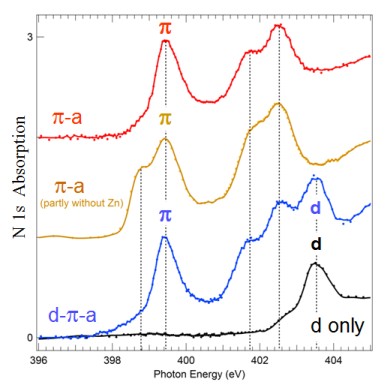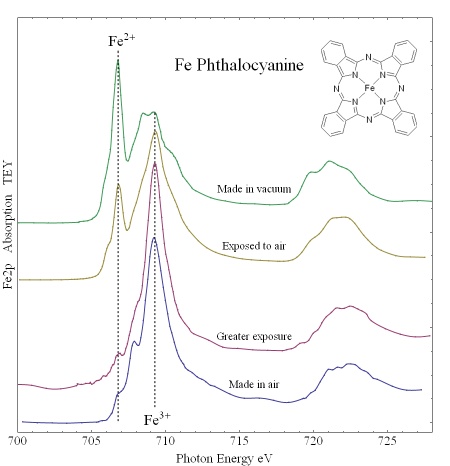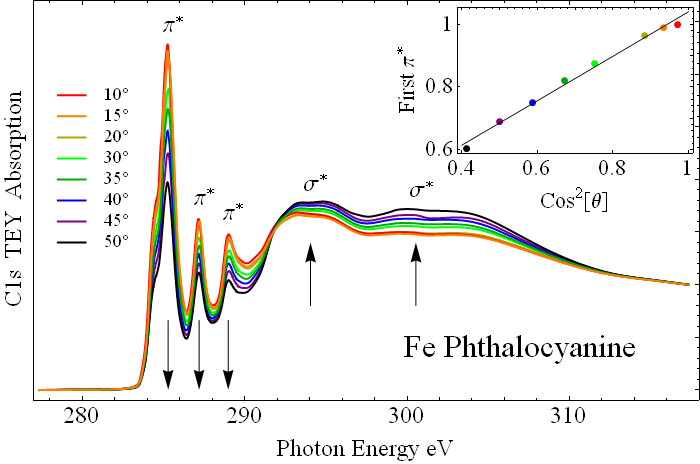
Porphyrins and phthalocyanines and their variations have been rather popular as dye molecules for solar cells. These molecules mimic the active center of biomolecules,
such as chlorophyll, hemoglobin, and cytochrome c. The latter is a small protein that plays a role
in biological charge transfer processes, a very useful property when it comes to separating electrons and holes in a solar cell. These biomolecules have been optimized by nature for billions of years. We are trying to take advantage of their high performance and to replicate their capabilities in smaller, more robust molecules.

The key to the performance of a solar cell are the energy levels of its components (shown above). The most generic solar cell involves of course a light absorber, where an incoming photon creates an electron-hole pair. In a dye molecule, the excited electron sits in the LUMO (lowest unoccupied molecular orbital), while the hole is located at the HOMO (highest occupied molecular orbital). In addition, one needs an electron acceptor level to extract the excited electron, plus an electron donor level to refill the hole. These four energy levels can all be varied independently to optimize the performance of a solar cell.
The excited electron eventually lands at the negative electrode (far left), travels around the external electrical circuit (not shown), and ends up at the positive electrode on the far right. The energy difference eVopen between the two electrodes determines the open circuit output voltage Vopen of the solar cell. It is given by the HOMO-LUMO gap, minus the sum of all energy drops between adjacent levels (LUMO - Acceptor - Negative Contact , Positive Contact - Donor - HOMO). Therefore, the output voltage is optimized by smaller energy drops. On the other hand, the output current is optimized by larger energy drops. Electrons and holes are extracted more quickly, which prevents them from recombining or getting trapped at defects. As a result, one has to strike a delicate balance when optimizing the power delivered by a solar cell, i.e., the product of voltage and current. For example, a typical dye-sensitized solar cell loses about half of its voltage due to a large energy drop on the donor side. That is needed to refill the hole at the HOMO quickly enough to prevent excited electrons from falling back into the hole.
The goal is to determine the energy levels by spectroscopic techniques and to use this knowledge for a systematic optimization of solar cells. Organic molecules can be modified in many different ways to tailor their energy levels. Unoccupied energy levels are revealed by X-ray absorption spectroscopy, and occupied orbitals by photoelectron spectroscopy. With X-ray absorption spectroscopy one can single out specific atoms inside a molecule by selecting the absorption edge of the appropriate atom (here the nitrogen 1s, iron 2p, and carbon 1s edges). Furthermore, one can select transitions into a specific molecular orbital, such as LUMO of a pi absorber versus that of a donor inside a donor-pi-acceptor complex (see the figure below). Even finer details can be distinguished, such as the influence of the central Zn atom on the surrounding N atoms.


Above: Donor-pi-acceptor complexes combine the three components of a solar cell in one molecule with atomic precision. They have enabled new efficiency records for dye-sensitized solar cells (see Yella et al., Science 334, 629 (2011). X-ray absorption spectroscopy makes it possible to probe individual orbitals at specific atoms. Examples are the LUMO of the donor (d) versus the LUMO of the pi-system of the absorber, both probed from their N atoms (via the N1s core level). The latter shifts downward when the central Zn2+ is accidentally replaced by two protons during the synthesis (yellow curve).
I. Zegkinoglou et al., Spectroscopy of Donor-pi-Acceptor Porphyrins for Dye-Sensitized Solar Cells , J. Phys. Chem. C 117, 13357 (2013).

Above: Using X-ray absorption spectroscopy in the fabrication of solar cells. In this case the oxidation state of dye molecules is probed within a depth of 5 nm. The oxidation state of the central Fe atom is found to be sensitive to the preparation of a molecular film. Sublimation in vacuum produces the multiplet structure of Fe2+ (top curve). After exposure to air, the spectrum becomes a mixture of Fe2+ and Fe3+ multiplets. Preparation from an ethanol solution produces mainly Fe3+ (bottom curve).
P. L. Cook et al., X-ray absorption spectroscopy of biomimetic dye molecules for solar cells , J. Chem. Phys. 131, 194701 (2009).

Above: The polarization of synchrotron radiation is used to determine the orientation of organic dye molecules, here for a thin film of Fe-phthalocyanine. The strong maximum of the pi* intensity at normal incidence (0 degrees) indicates that the molecules are well oriented and that the molecular plane is nearly perpendicular to the surface. Having all molecules oriented in the same direction helps optimizing the overlap between adjacent molecular layers, and with it the mobility of the electrons in organic electronics.
P. L. Cook et al., X-ray absorption spectroscopy of biomimetic dye molecules for solar cells , J. Chem. Phys. 131, 194701 (2009).
There are many other materials to be explored for solar cells. For example, we have measured the energy levels of highly p-doped diamond, which represents a chemically-robust and transparent donor (see references below). It complements n-doped TiO2, a widely-used transparent acceptor. Looking farther into the future, one can imagine synthesizing tandem solar cells with atomic precision by adding an extra absorber to a donor-pi-acceptor complex (see Ørnsø et al. below). To stitch them together will require pi-bonded molecular wires. Thus we have started to explore their energy levels and orbitals (see the last reference below).
Further reading:
J.M. Garcia-Lastra et al., Communication: Systematic shifts of the lowest unoccupied molecular orbital peak in x-ray absorption for a series of 3d metal porphyrins , J. Chem. Phys. 133, 151103 (2010).
P. L. Cook et al., Unoccupied states in Cu and Zn octaethyl-porphyrin and phthalocyanine , J. Chem. Phys. 134, 204707 (2011).
I. Zegkinoglou et al., Electronic Structure of Diamond Surfaces Functionalized by Ru(tpy)2 , J. Phys. Chem. C 116, 13877 (2012).
M. Kapilashrami et al., Boron-Doped Diamond Films as Electron Donors in Photovoltaics: An X-Ray Absorption and Hard X-Ray Photoemission Study , J. Appl. Phys. 116, 143702 (2014).
P. S. Johnson et al., Electronic Structure of Fe- vs. Ru-Based Dye Molecules , J. Chem. Phys. 138, 044709 (2013).
K. B. Ørnsø et al., Design of two-photon molecular tandem architectures for solar cells by ab initio theory , Chemical Science 6, 3018 (2015).
J.M. Garcia-Lastra et al., Electronic Structure of Low-Dimensional Carbon pi-Systems , J. Phys. Chem. C 120, 12362 (2016).